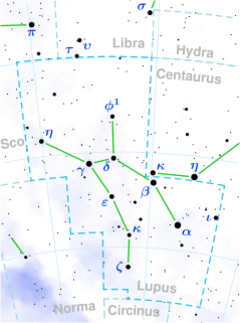Astronomy:Delta Lupi
| Observation data Equinox J2000.0]] (ICRS) | |
|---|---|
| Constellation | Lupus |
| Right ascension | 15h 21m 22.32168s[1] |
| Declination | −40° 38′ 51.0738″[1] |
| Apparent magnitude (V) | 3.20 - 3.24[2] |
| Characteristics | |
| Spectral type | B1.5 IV[3] |
| U−B color index | −0.910[4] |
| B−V color index | −0.224[4] |
| Variable type | β Cep[5][2] |
| Astrometry | |
| Radial velocity (Rv) | +0.2[6] km/s |
| Proper motion (μ) | RA: −19.49[1] mas/yr Dec.: −25.29[1] mas/yr |
| Parallax (π) | 3.69 ± 0.54[1] mas |
| Distance | approx. 900 ly (approx. 270 pc) |
| Absolute magnitude (MV) | −3.1[7] |
| Details | |
| Mass | 11.9±0.2[8] M☉ |
| Radius | 6.1[9] R☉ |
| Luminosity | 10,000[8] L☉ |
| Surface gravity (log g) | 3.86[8] cgs |
| Temperature | 22,908[8] K |
| Metallicity [Fe/H] | −0.25±0.11[10] dex |
| Rotational velocity (v sin i) | 230[11] km/s |
| Age | 15.4±1.3[8] Myr |
| Other designations | |
| Database references | |
| SIMBAD | data |
Delta Lupi (δ Lupi, δ Lup) is a star in the southern circumpolar constellation of Lupus. In traditional Chinese astronomy, it is "the 2nd (star) of the Cavalry Officer" (騎官二). With an apparent visual magnitude of 3.2, it is the fourth-brightest star in the constellation. The distance to this star has been measured using the parallax technique, yielding an estimate of roughly 900 light-years with a 15% margin of error.[1]
The spectrum of this star matches a stellar classification of B1.5 IV,[3] which indicates this star has entered the subgiant stage and is in the process of evolving into a giant star. It is radiating around 10,000 times the luminosity of the Sun from its outer atmosphere at an effective temperature of 23,000 K, giving it a blue-white hue. This star has nearly 12 times the mass of the Sun and is roughly 15 million years old.[8]
Delta Lupi is a Beta Cephei variable star that undergoes periodic pulsations. It has a single period of variability lasting 0.1655 days, or six cycles per day.[5] This is a proper motion member of the Upper Centaurus–Lupus sub-group in the Scorpius–Centaurus OB association, the nearest such co-moving association of massive stars to the Sun.[7]
See also
References
- ↑ 1.0 1.1 1.2 1.3 1.4 1.5 van Leeuwen, F. (November 2007). "Validation of the new Hipparcos reduction". Astronomy and Astrophysics 474 (2): 653–664. doi:10.1051/0004-6361:20078357. Bibcode: 2007A&A...474..653V.
- ↑ 2.0 2.1 Samus’, N. N.; Kazarovets, E. V.; Durlevich, O. V.; Kireeva, N. N.; Pastukhova, E. N. (January 2017). "General catalogue of variable stars: Version GCVS 5.1". Astronomy Reports 61 (1): 80–88. doi:10.1134/S1063772917010085. ISSN 1063-7729. Bibcode: 2017ARep...61...80S.
- ↑ 3.0 3.1 Hiltner, W. A.; Garrison, R. F.; Schild, R. E. (July 1969), "MK spectral types for bright southern OB stars", Astrophysical Journal 157: 313, doi:10.1086/150069, Bibcode: 1969ApJ...157..313H
- ↑ 4.0 4.1 Gutierrez-Moreno, Adelina; Moreno, Hugo (June 1968), "A photometric investigation of the Scorpio-Centaurus association", Astrophysical Journal Supplement 15: 459, doi:10.1086/190168, Bibcode: 1968ApJS...15..459G
- ↑ 5.0 5.1 Smolec, R.; Moskalik, P. (May 2007), "Amplitude saturation in β Cephei models", Monthly Notices of the Royal Astronomical Society 377 (2): 645–656, doi:10.1111/j.1365-2966.2007.11620.x, Bibcode: 2007MNRAS.377..645S
- ↑ Evans, D. S. (June 20–24, 1966). "The Revision of the General Catalogue of Radial Velocities". in Batten, Alan Henry; Heard, John Frederick. IAU Symposium no. 30. 30. University of Toronto: International Astronomical Union. p. 57. Bibcode: 1967IAUS...30...57E.
- ↑ 7.0 7.1 de Geus, E. J.; de Zeeuw, P. T.; Lub, J. (June 1989), "Physical parameters of stars in the Scorpio-Centaurus OB association", Astronomy and Astrophysics 216 (1–2): 44–61, Bibcode: 1989A&A...216...44D
- ↑ 8.0 8.1 8.2 8.3 8.4 8.5 Tetzlaff, N.; Neuhäuser, R.; Hohle, M. M. (January 2011), "A catalogue of young runaway Hipparcos stars within 3 kpc from the Sun", Monthly Notices of the Royal Astronomical Society 410 (1): 190–200, doi:10.1111/j.1365-2966.2010.17434.x, Bibcode: 2011MNRAS.410..190T
- ↑ Underhill, A. B. et al. (November 1979), "Effective temperatures, angular diameters, distances and linear radii for 160 O and B stars", Monthly Notices of the Royal Astronomical Society 189 (3): 601–605, doi:10.1093/mnras/189.3.601, Bibcode: 1979MNRAS.189..601U
- ↑ Niemczura, E.; Daszyńska-Daszkiewicz, J. (April 2005), "Metallicities of the β Cephei stars from low-resolution ultraviolet spectra", Astronomy and Astrophysics 433 (2): 659–669, doi:10.1051/0004-6361:20040396, Bibcode: 2005A&A...433..659N. Note: value taken from [m/H].
- ↑ Bernacca, P. L.; Perinotto, M. (1970). "A catalogue of stellar rotational velocities". Contributi Osservatorio Astronomico di Padova in Asiago 239 (1): 1. Bibcode: 1970CoAsi.239....1B.
- ↑ "del Lup". SIMBAD. Centre de données astronomiques de Strasbourg. http://simbad.u-strasbg.fr/simbad/sim-basic?Ident=del+Lup.
- ↑ "MAST: Barbara A. Mikulski Archive for Space Telescopes". Space Telescope Science Institute. https://mast.stsci.edu/portal/Mashup/Clients/Mast/Portal.html.
 |



